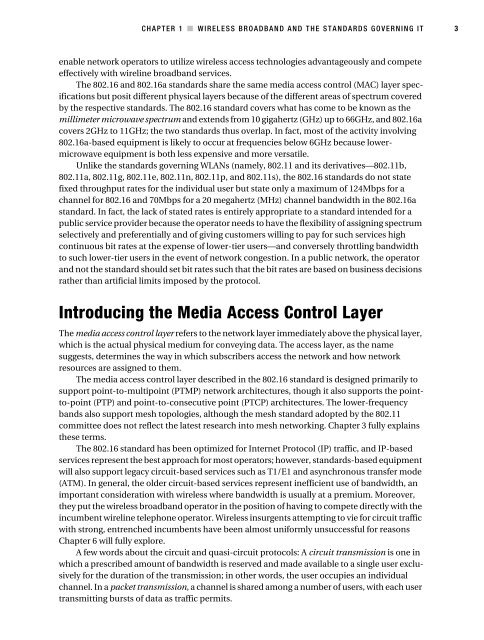WiMax Operator's Manual
WiMax Operator's Manual
WiMax Operator's Manual
Create successful ePaper yourself
Turn your PDF publications into a flip-book with our unique Google optimized e-Paper software.
CHAPTER 1 ■ WIRELESS BROADBAND AND THE STANDARDS GOVERNING IT 3<br />
enable network operators to utilize wireless access technologies advantageously and compete<br />
effectively with wireline broadband services.<br />
The 802.16 and 802.16a standards share the same media access control (MAC) layer specifications<br />
but posit different physical layers because of the different areas of spectrum covered<br />
by the respective standards. The 802.16 standard covers what has come to be known as the<br />
millimeter microwave spectrum and extends from 10 gigahertz (GHz) up to 66GHz, and 802.16a<br />
covers 2GHz to 11GHz; the two standards thus overlap. In fact, most of the activity involving<br />
802.16a-based equipment is likely to occur at frequencies below 6GHz because lowermicrowave<br />
equipment is both less expensive and more versatile.<br />
Unlike the standards governing WLANs (namely, 802.11 and its derivatives—802.11b,<br />
802.11a, 802.11g, 802.11e, 802.11n, 802.11p, and 802.11s), the 802.16 standards do not state<br />
fixed throughput rates for the individual user but state only a maximum of 124Mbps for a<br />
channel for 802.16 and 70Mbps for a 20 megahertz (MHz) channel bandwidth in the 802.16a<br />
standard. In fact, the lack of stated rates is entirely appropriate to a standard intended for a<br />
public service provider because the operator needs to have the flexibility of assigning spectrum<br />
selectively and preferentially and of giving customers willing to pay for such services high<br />
continuous bit rates at the expense of lower-tier users—and conversely throttling bandwidth<br />
to such lower-tier users in the event of network congestion. In a public network, the operator<br />
and not the standard should set bit rates such that the bit rates are based on business decisions<br />
rather than artificial limits imposed by the protocol.<br />
Introducing the Media Access Control Layer<br />
The media access control layer refers to the network layer immediately above the physical layer,<br />
which is the actual physical medium for conveying data. The access layer, as the name<br />
suggests, determines the way in which subscribers access the network and how network<br />
resources are assigned to them.<br />
The media access control layer described in the 802.16 standard is designed primarily to<br />
support point-to-multipoint (PTMP) network architectures, though it also supports the pointto-point<br />
(PTP) and point-to-consecutive point (PTCP) architectures. The lower-frequency<br />
bands also support mesh topologies, although the mesh standard adopted by the 802.11<br />
committee does not reflect the latest research into mesh networking. Chapter 3 fully explains<br />
these terms.<br />
The 802.16 standard has been optimized for Internet Protocol (IP) traffic, and IP-based<br />
services represent the best approach for most operators; however, standards-based equipment<br />
will also support legacy circuit-based services such as T1/E1 and asynchronous transfer mode<br />
(ATM). In general, the older circuit-based services represent inefficient use of bandwidth, an<br />
important consideration with wireless where bandwidth is usually at a premium. Moreover,<br />
they put the wireless broadband operator in the position of having to compete directly with the<br />
incumbent wireline telephone operator. Wireless insurgents attempting to vie for circuit traffic<br />
with strong, entrenched incumbents have been almost uniformly unsuccessful for reasons<br />
Chapter 6 will fully explore.<br />
A few words about the circuit and quasi-circuit protocols: A circuit transmission is one in<br />
which a prescribed amount of bandwidth is reserved and made available to a single user exclusively<br />
for the duration of the transmission; in other words, the user occupies an individual<br />
channel. In a packet transmission, a channel is shared among a number of users, with each user<br />
transmitting bursts of data as traffic permits.
















